Continued Hydrothermal and Radiative Pressure on Changed Cropland in China
Abstract
1. Introduction
2. Materials and Methods
2.1. Study Data
2.2. Methods
3. Results
3.1. Temporal and Spatial Changes of Cropland
3.2. Temporal and Spatial Changes of Hydrothermal Conditions.
3.3. Temporal and Spatial Changes of Solar Radiation
3.4. Changes in Hydrothermal and Radiation Conditions with the Cropland Dynamics
4. Discussion
4.1. Impact Factors of Cropland Dynamics
4.2. Hydrothermal and Radiation Pressure of Cropland
5. Conclusions
Author Contributions
Funding
Acknowledgments
Conflicts of Interest
References
- Anderson, K.; Strutt, A. Food security policy options for China: Lessons from other countries. Food Policy 2014, 49, 50–58. [Google Scholar] [CrossRef]
- Ministry of Science and Technology. Third National Assessment Report on Climate Change of China; Science Press: Beijing, China, 2015.
- Rounsevell, M.D.A.; Ewert, F.; Reginster, I.; Leemans, R.; Carter, T.R. Future scenarios of European agricultural land use. II. Projecting changes in cropland and grassland. Agric. Ecosyst. Environ. 2005, 107, 117–135. [Google Scholar] [CrossRef]
- Lee, H.L. The impact of climate change on global food supply and demand, food prices, and land use. Paddy Water Environ. 2009, 7, 321–331. [Google Scholar] [CrossRef]
- D’Amour, C.B.; Reitsma, F.; Baiocchi, G.; Barthel, S.; Güneralp, B.; Erb, K.-H.; Haberl, H.; Creutzig, F.; Seto, K.C. Future urban land expansion and implications for global croplands. Proc. Natl. Acad. Sci. USA 2017, 114, 8939–8944. [Google Scholar] [CrossRef] [PubMed]
- Liu, J.; Ning, J.; Kuang, W.; Xu, X.; Zhang, S.; Yan, C.; Li, R.; Wu, S.; Hu, Y.; Du, G. Spatiotemporal patterns and characteristics of land-use change in China during 2010–2015. J. Geogr. Sci. 2018, 28, 547–562. [Google Scholar]
- Liu, J.; Kuang, W.; Zhang, Z.; Xu, X.; Qin, Y.; Ning, J.; Zhou, W.; Zhang, S.; Li, R.; Yan, C. Spatiotemporal characteristics, patterns, and causes of land-use changes in China since the late 1980s. J. Geogr. Sci. 2014, 24, 195–210. [Google Scholar] [CrossRef]
- Chen, J. Rapid urbanization in China: A real challenge to soil protection and food security. Catena 2007, 69, 1–15. [Google Scholar] [CrossRef]
- Qin, Y.; Yan, H.; Liu, J.; Dong, J.; Chen, J.; Xiao, X. Impacts of ecological restoration projects on agricultural productivity in China. J. Geogr. Sci. 2013, 23, 404–416. [Google Scholar] [CrossRef]
- Guo, X.; Chang, Q.; Xiao, L.; Bao, H.; Zhang, Y.; Tu, X.; Zhu, C.; Lv, C.; Zhang, Y. Multi-dimensional eco-land classification and management for implementing the ecological redline policy in China. Land Use Policy 2018, 74, 15–31. [Google Scholar] [CrossRef]
- Deng, X.; Xu, D.; Qi, Y.; Zeng, M. Labor off-farm employment and cropland abandonment in rural China: Spatial distribution and empirical analysis. Int. J. Environ. Res. Public Health 2018, 15, 1808. [Google Scholar] [CrossRef]
- Cui, Y.; Liu, J.; Xu, X.; Dong, J.; Li, N.; Fu, Y.; Lu, S.; Xia, H.; Si, B.; Xiao, X. Accelerating Cities in an Unsustainable Landscape: Urban Expansion and Cropland Occupation in China, 1990–2030. Sustainability 2019, 11, 2283. [Google Scholar] [CrossRef]
- Wang, J.; Dong, J.; Yi, Y.; Lu, G.; Oyler, J.; Smith, W.; Zhao, M.; Liu, J.; Running, S. Decreasing net primary production due to drought and slight decreases in solar radiation in China from 2000 to 2012. J. Geophys. Res. Biogeosci. 2017, 122, 261–278. [Google Scholar] [CrossRef]
- Zhai, R.; Tao, F. Contributions of climate change and human activities to runoff change in seven typical catchments across China. Sci. Total Environ. 2017, 605, 219–229. [Google Scholar] [CrossRef] [PubMed]
- Li, J.; Cui, Y.; Liu, J.; Shi, W.; Qin, Y. Estimation and analysis of net primary productivity by integrating MODIS remote sensing data with a light use efficiency model. Ecol. Model. 2013, 252, 3–10. [Google Scholar] [CrossRef]
- Hamby, A.L. Estimation of solar radiation for use in crop modeling. Agric. For. Meteorol. 1998, 91, 293–300. [Google Scholar]
- Abraha, M.G.; Savage, M.J. Comparison of estimates of daily solar radiation from air temperature range for application in crop simulations. Agric. For. Meteorol. 2008, 148, 0–416. [Google Scholar] [CrossRef]
- Mu, J.E.; Mccarl, B.A.; Sleeter, B.; Abatzoglou, J.T.; Zhang, H. Adaptation with climate uncertainty: An examination of agricultural land use in the United States. Land Use Policy 2018, 77, 392–401. [Google Scholar] [CrossRef]
- Cui, Y.; Ning, X.; Qin, Y.; Xu, L.I.; Chen, Y. Spatio-temporal changes in agricultural hydrothermal conditions in China from 1951 to 2010. J. Geogr. Sci. 2016, 26, 643–657. [Google Scholar] [CrossRef]
- Dong, J.; Xiao, X.; Zhang, G.; Menarguez, M.A.; Choi, C.Y.; Qin, Y.; Luo, P.; Zhang, Y.; Moore, B. Northward expansion of paddy rice in northeastern Asia during 2000-2014. Geophys. Res. Lett. 2016, 43, 3754–3761. [Google Scholar] [CrossRef]
- Liu, J.; Liu, M.; Tian, H.; Zhuang, D.; Zhang, Z.; Zhang, W.; Tang, X.; Deng, X. Spatial and temporal patterns of China’s cropland during 1990-2000: An analysis based on Landsat TM data. Remote. Sens. Environ. 2005, 98, 442–456. [Google Scholar] [CrossRef]
- Hutchinson, M.F. Interpolation of rainfall data with thin plate smoothing splines. Part I: Two dimensional smoothing of data with short range correlation. J. Geogr. Inform. Decis. Anal. 1998, 2, 139–151. [Google Scholar]
- Jiang, C.; Ryu, Y. Multi-scale evaluation of global gross primary productivity and evapotranspiration products derived from Breathing Earth System Simulator (BESS). Remote Sens. Environ. 2016, 186, 528–547. [Google Scholar] [CrossRef]
- Liu, Y.; Li, J.; Yang, Y. Strategic adjustment of land use policy under the economic transformation. Land Use Policy 2018, 74, 5–14. [Google Scholar] [CrossRef]
- Knight, J.; Kennedy, J.; Folland, C.; Harris, G.; Jones, G.; Palmer, M.; Parker, D.; Scaife, A.; Stott, P. Do global temperature trends over the last decade falsify climate predictions. Bull. Am. Meteorol. Soc. 2009, 90, 22–23. [Google Scholar]
- Yamamoto, T.; Jalaldin, A.; Maimaidi, A.; Nagasawa, T. Land reclamation and water management in an arid region: A case study of Xayar county in Xinjiang Uygur autonomous region, China. WIT Trans. Ecol. Environ. 2010, 134, 3–14. [Google Scholar]
- Huang, L.; Shao, Q.; Liu, J. Forest restoration to achieve both ecological and economic progress, Poyang Lake basin, China. Ecol. Eng. 2012, 44, 53–60. [Google Scholar] [CrossRef]
- Wang, N.; Jiao, J.Y.; Jia, Y.F.; Bai, W.J.; Zhang, Z.G. Germinable Soil Seed Banks and the Restoration Potential of Abandoned Cropland on the Chinese Hilly-Gullied Loess Plateau. Environ. Manag. 2010, 46, 367–377. [Google Scholar] [CrossRef]
- Zou, Y.; Zhang, Z.; Zhou, Q.; Zhao, X. Land use change dynamics spatial pattern in ecotone between agriculture and animal husbandry and its driving force analysis. J. Nat. Resour. 2003, 2, 222–227. [Google Scholar]
- Wang, J.; Xu, X.; Liu, P. Landuse and land carrying capacity in ecotone between agriculture and animal husbandry in northern China. Res. Sci. 1999, 21, 21–26. [Google Scholar]
- Mueller, N.D.; Rhines, A.; Butler, E.E.; Ray, D.K.; Siebert, S.; Holbrook, N.M.; Huybers, P. Global relationships between cropland intensification and summer temperature extremes over the last 50 years. J. Clim. 2017, 30, 7505–7528. [Google Scholar] [CrossRef]
- Cui, Y. Preliminary estimation of the realistic optimum temperature for vegetation growth in China. Environ. Manag. 2013, 52, 151–162. [Google Scholar] [CrossRef] [PubMed]
- Wu, W.; Yu, Q.; You, L.; Chen, K.; Tang, H.; Liu, J. Global cropping intensity gaps: Increasing food production without cropland expansion. Land Use Policy 2018, 76, 515–525. [Google Scholar] [CrossRef]
- Demetriades-Shah, T.H.; Fuchs, M.; Kanemasu, E.T.; Flitcroft, I. A note of caution concerning the relationship between cumulated intercepted solar radiation and crop growth. Agric. For. Meteorol. 1992, 58, 193–207. [Google Scholar] [CrossRef]
- Jie, Z.; Mu, Q.; Huang, J. Assessing the remotely sensed Drought Severity Index for agricultural drought monitoring and impact analysis in North China. Ecol. Indic. 2016, 63, 296–309. [Google Scholar]
- Doughty, R.; Xiao, X.; Wu, X.; Yao, Z.; Bajgain, R.; Zhou, Y.; Qin, Y.; Zou, Z.; Mccarthy, H.; Friedman, J. Responses of gross primary production of grasslands and croplands under drought, pluvial, and irrigation conditions during 2010–2016, Oklahoma, USA. Agric. Water Manag. 2018, 204, 47–59. [Google Scholar] [CrossRef]
- Li, X.; Li, H.; Yang, L.; Ren, Y. Assessment of soil quality of croplands in the Corn Belt of Northeast China. Sustainability 2018, 10, 248. [Google Scholar] [CrossRef]
- Song, W.; Liu, M. Farmland conversion decreases regional and national land quality in China. Land Degrad. Dev. 2017, 28, 459–471. [Google Scholar] [CrossRef]
- Seto, K.C.; Ramankutty, N. Hidden linkages between urbanization and food systems. Science 2016, 352, 943–945. [Google Scholar] [CrossRef]
- Liu, J.; Zhuang, D.; Luo, D.; Xiao, X. Land-cover classification of china: Integrated analysis of avhrr imagery and geophysical data. Int. J. Remote Sens. 2003, 24, 2485–2500. [Google Scholar] [CrossRef]
- Lu, Y.; Jiang, S.; Ren, L.; Zhang, L.; Wang, M.; Liu, R.; Wei, L. Spatial and temporal variability in precipitation concentration over mainland China, 1961–2017. Water 2019, 11, 881. [Google Scholar] [CrossRef]
- Kabir, E.; Kumar, P.; Kumar, S.; Adelodun, A.A.; Kim, K.H. Solar energy: Potential and future prospects. Renew. Sustain. Energy Rev. 2017, 82, 894–900. [Google Scholar] [CrossRef]
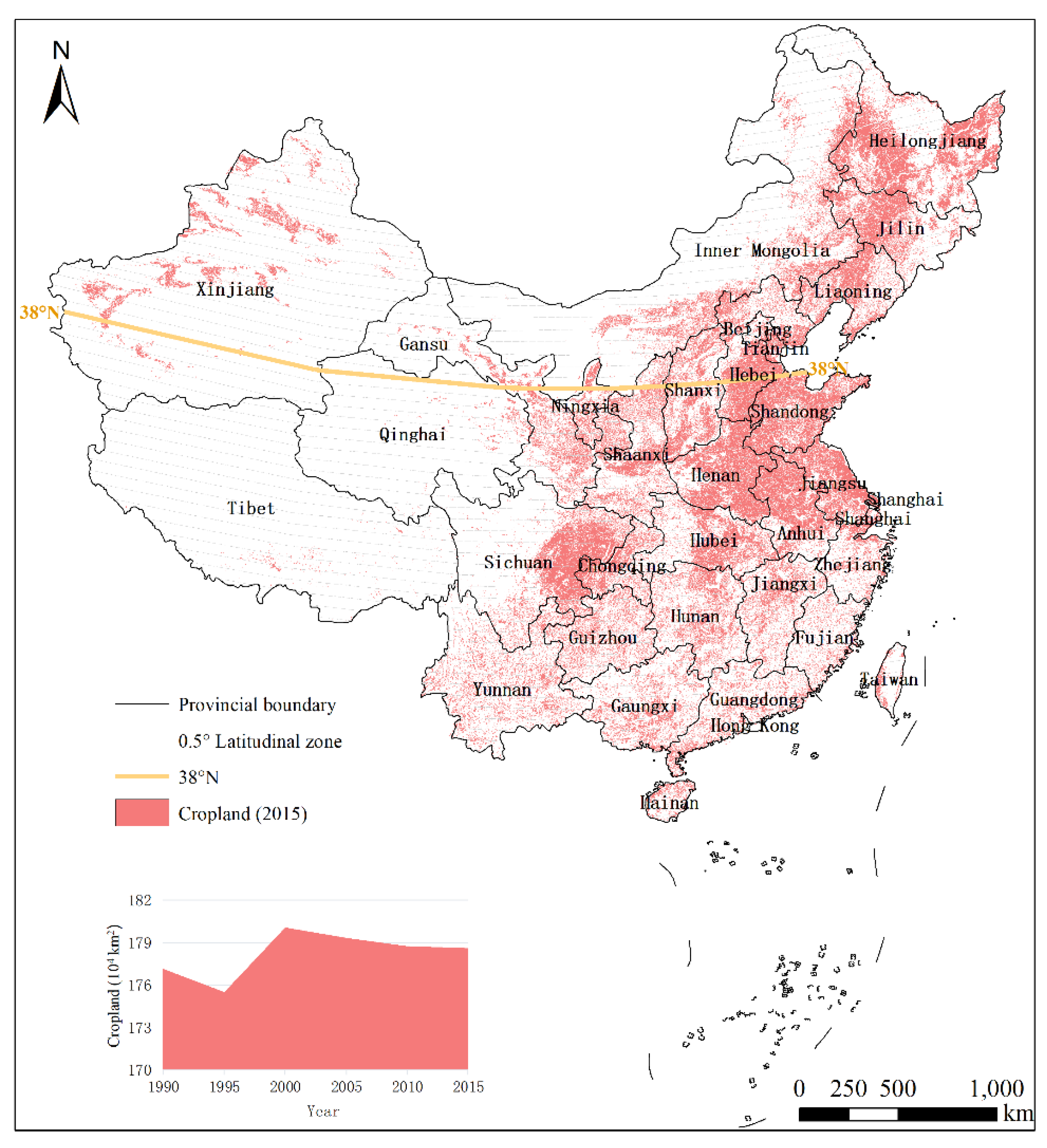


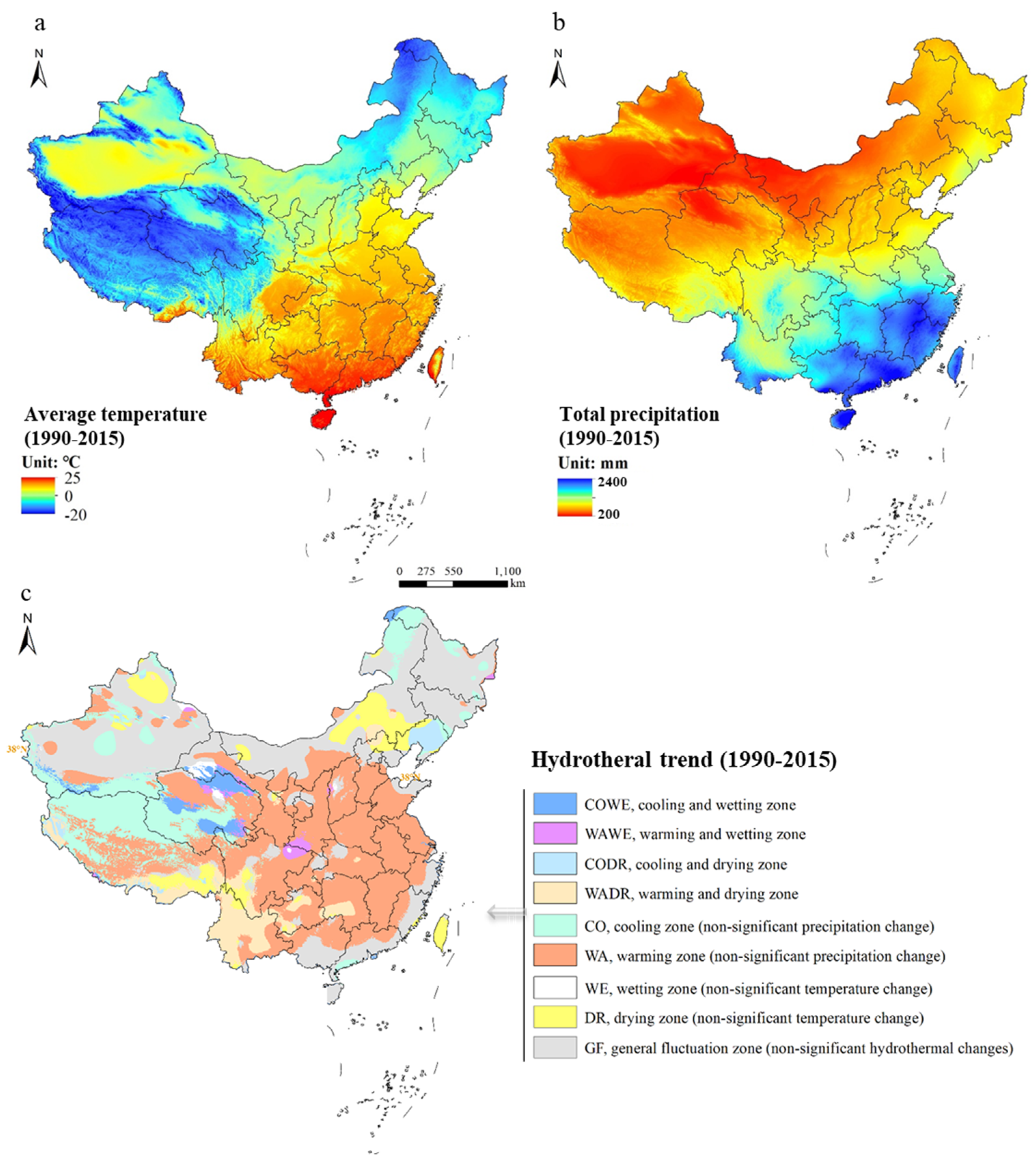
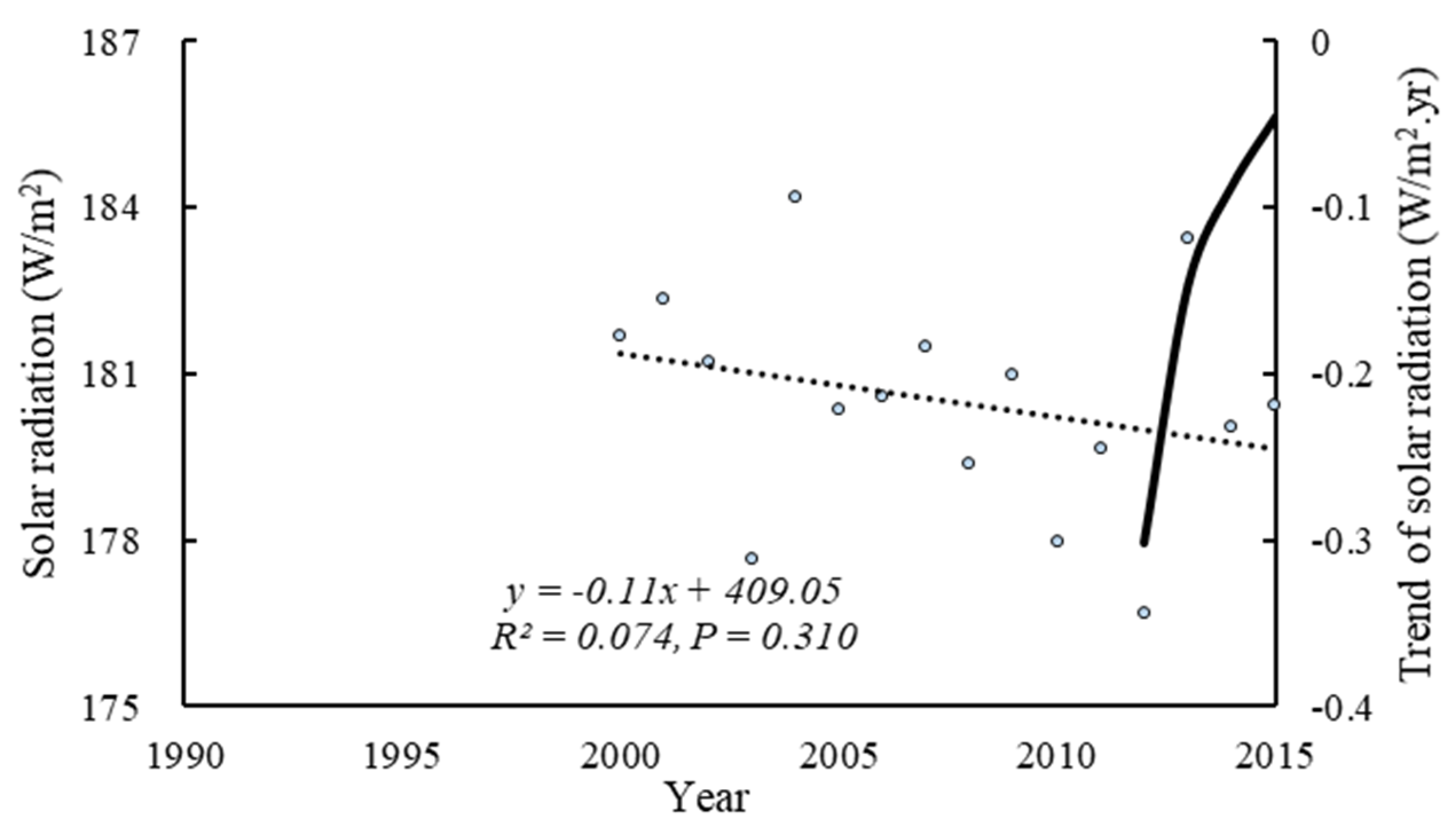
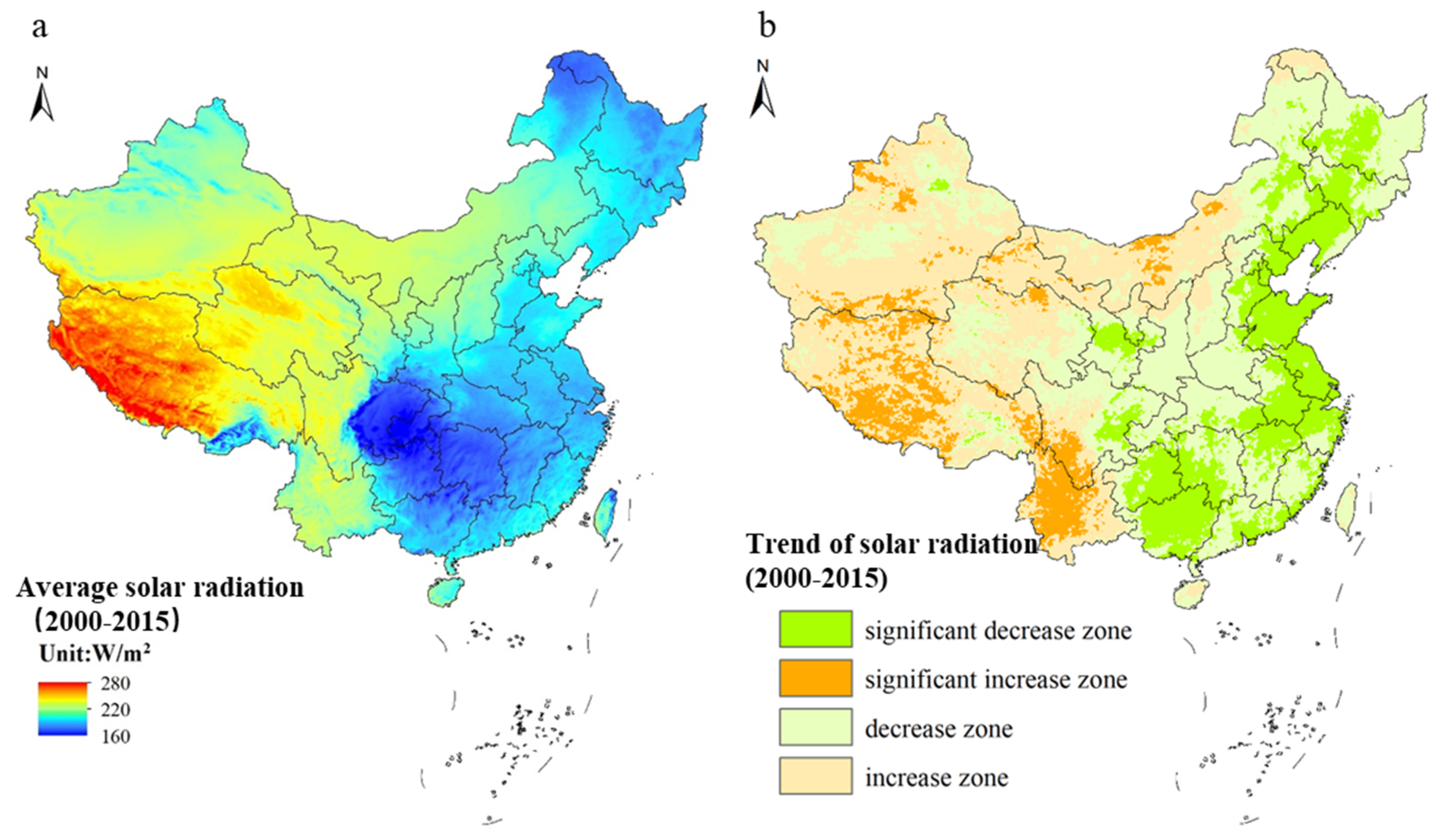


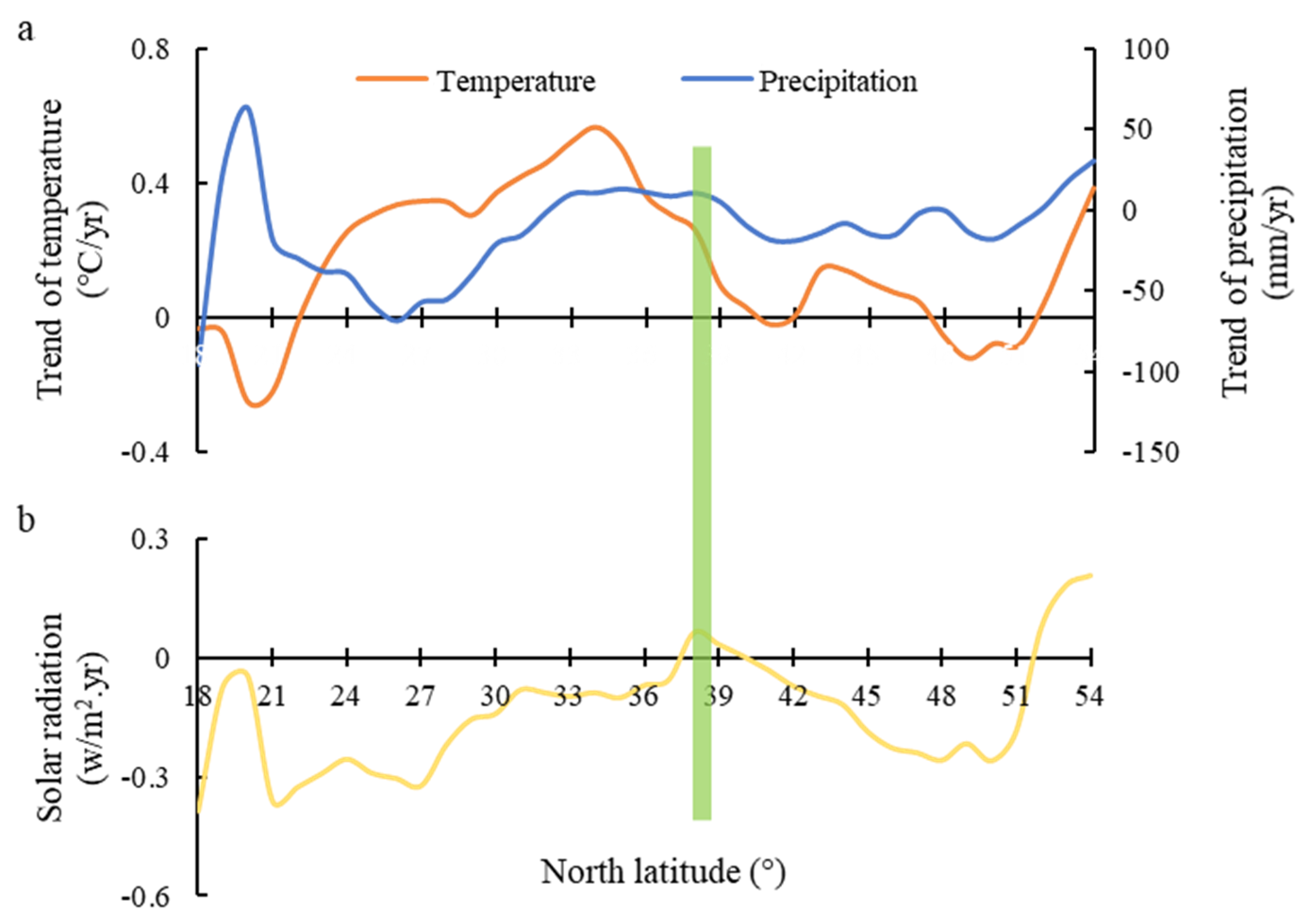
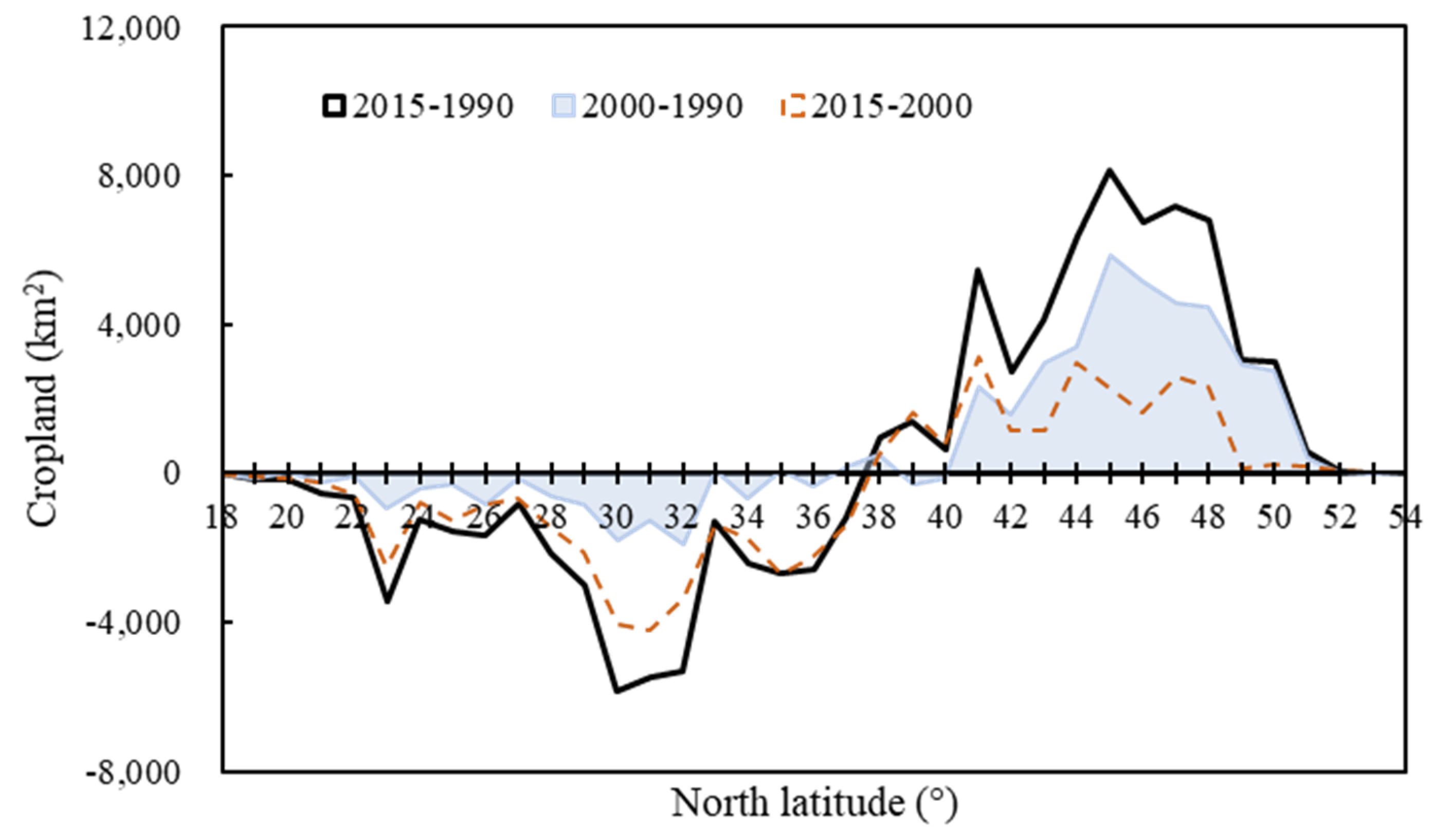
© 2019 by the authors. Licensee MDPI, Basel, Switzerland. This article is an open access article distributed under the terms and conditions of the Creative Commons Attribution (CC BY) license (http://creativecommons.org/licenses/by/4.0/).
Share and Cite
Fu, Y.; Cui, Y.; Qin, Y.; Li, N.; Chen, L.; Xia, H. Continued Hydrothermal and Radiative Pressure on Changed Cropland in China. Sustainability 2019, 11, 3762. https://doi.org/10.3390/su11143762
Fu Y, Cui Y, Qin Y, Li N, Chen L, Xia H. Continued Hydrothermal and Radiative Pressure on Changed Cropland in China. Sustainability. 2019; 11(14):3762. https://doi.org/10.3390/su11143762
Chicago/Turabian StyleFu, Yiming, Yaoping Cui, Yaochen Qin, Nan Li, Liangyu Chen, and Haoming Xia. 2019. "Continued Hydrothermal and Radiative Pressure on Changed Cropland in China" Sustainability 11, no. 14: 3762. https://doi.org/10.3390/su11143762
APA StyleFu, Y., Cui, Y., Qin, Y., Li, N., Chen, L., & Xia, H. (2019). Continued Hydrothermal and Radiative Pressure on Changed Cropland in China. Sustainability, 11(14), 3762. https://doi.org/10.3390/su11143762






